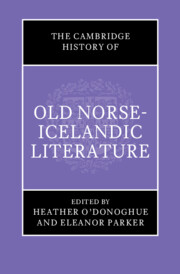Book contents
- The Cambridge History of Old Norse-Icelandic Literature
- The Cambridge History of Old Norse-Icelandic Literature
- Copyright page
- Contents
- Contributors
- Abbreviations
- Introduction
- Part I Contexts
- Part II The Distant Past
- Part III The Saga Age
- Part IV The New Christian World
- 14 Conversion and Literature
- 15 Saints’ Lives
- 16 Christian Poetry
- 17 Homilies and Christian Instruction
- 18 Biskupa sögur
- PART V Beyond Iceland
- Part VI Compilations
- Glossary
- Bibliography
- Index
18 - Biskupa sögur
from Part IV - The New Christian World
Published online by Cambridge University Press: 08 February 2024
- The Cambridge History of Old Norse-Icelandic Literature
- The Cambridge History of Old Norse-Icelandic Literature
- Copyright page
- Contents
- Contributors
- Abbreviations
- Introduction
- Part I Contexts
- Part II The Distant Past
- Part III The Saga Age
- Part IV The New Christian World
- 14 Conversion and Literature
- 15 Saints’ Lives
- 16 Christian Poetry
- 17 Homilies and Christian Instruction
- 18 Biskupa sögur
- PART V Beyond Iceland
- Part VI Compilations
- Glossary
- Bibliography
- Index
Summary
The Biskupa sögur (sagas of bishops) deal with the lives of six medieval Icelandic bishops, covering the history of Iceland’s two bishoprics, Skálholt and Hólar, from the mid eleventh century to the fourteenth century. They are important sources for Icelandic church history and the lives of individual bishops, three of whom were venerated as saints. This chapter provides a history of the genre, surveying texts about the saints Þorlákr Þórhallsson, Jón Ögmundsson and Guðmundr Arason, the chronicle Hungrvaka, which records the lives of the five bishops who preceded St Þorlákr, the sagas of three other bishops, Páls saga, Árna saga Þorlákssonar and Lárentíus saga Kálfssonar, and two þættir, Ísleifs þáttr and Jóns þáttr Halldórssonar. This genre has received less scholarly attention than some other genres of Icelandic literature, but this chapter argues that the sagas have much to offer historians and literary scholars. It examines the role of miracle-stories within the sagas and considers what these texts can tell us about such questions as the relationship between memory and literacy in medieval Iceland, the expression of emotion, masculinity, sexuality and celibacy.
Keywords
- Type
- Chapter
- Information
- The Cambridge History of Old Norse-Icelandic Literature , pp. 372 - 390Publisher: Cambridge University PressPrint publication year: 2024

